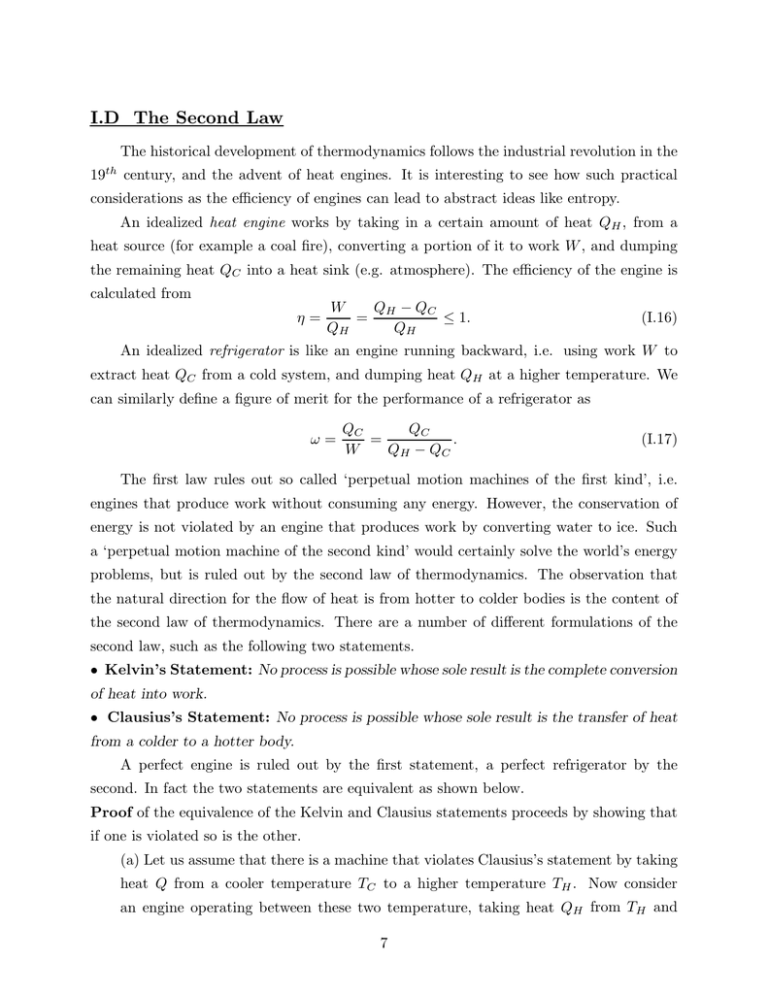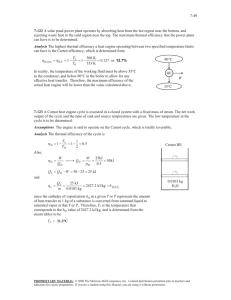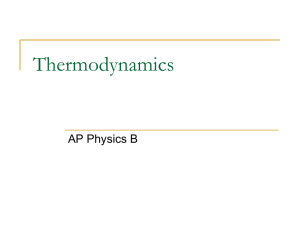I.D The Second Law
advertisement

I.D The Second Law
The historical development of thermodynamics follows the industrial revolution in the
19
th
century, and the advent of heat engines. It is interesting to see how such practical
considerations as the efficiency of engines can lead to abstract ideas like entropy.
An idealized heat engine works by taking in a certain amount of heat QH , from a
heat source (for example a coal fire), converting a portion of it to work W , and dumping
the remaining heat QC into a heat sink (e.g. atmosphere). The efficiency of the engine is
calculated from
η=
W
QH − QC
=
≤ 1.
QH
QH
(I.16)
An idealized refrigerator is like an engine running backward, i.e. using work W to
extract heat QC from a cold system, and dumping heat QH at a higher temperature. We
can similarly define a figure of merit for the performance of a refrigerator as
ω=
QC
QC
=
.
W
QH − QC
(I.17)
The first law rules out so called ‘perpetual motion machines of the first kind’, i.e.
engines that produce work without consuming any energy. However, the conservation of
energy is not violated by an engine that produces work by converting water to ice. Such
a ‘perpetual motion machine of the second kind’ would certainly solve the world’s energy
problems, but is ruled out by the second law of thermodynamics. The observation that
the natural direction for the flow of heat is from hotter to colder bodies is the content of
the second law of thermodynamics. There are a number of different formulations of the
second law, such as the following two statements.
• Kelvin’s Statement: No process is possible whose sole result is the complete conversion
of heat into work.
• Clausius’s Statement: No process is possible whose sole result is the transfer of heat
from a colder to a hotter body.
A perfect engine is ruled out by the first statement, a perfect refrigerator by the
second. In fact the two statements are equivalent as shown below.
Proof of the equivalence of the Kelvin and Clausius statements proceeds by showing that
if one is violated so is the other.
(a) Let us assume that there is a machine that violates Clausius’s statement by taking
heat Q from a cooler temperature TC to a higher temperature TH . Now consider
an engine operating between these two temperature, taking heat QH from TH and
7
dumping QC at TC . The combined system takes QH − Q from TH , produces work
equal to QH − QC and dumps QC − Q at TC . If we adjust the engine output such that
QC = Q, the net result is a 100% efficient engine, in violation of Kelvin’s statement.
(b) Alternatively, assume a machine that violates Kelvin’s law by taking heat Q and
converting it completely to work. The work output of this machine can be used to
run a refrigerator, with the net outcome of transferring heat from a colder to a hotter
body, in violation of Clausius’s statement.
Although these statements may appear as rather trivial and qualitative descriptions,
they have important quantitative implications as demonstrated in the next sections.
I.E Carnot Engines & Thermodynamic Temperature
• A Carnot Engine is any engine that is reversible, runs in a cycle, with all of its heat
exchanges taking place at a source temperature TH , and a sink temperature TC .
A reversible process is one that can be run backward in time by simply reversing its
inputs and outputs. It is the thermodynamic equivalent of frictionless motion in mechanics.
Since time reversibility implies equilibrium, a reversible transformation must be quasistatic, but the reverse is not necessarily true (e.g., if there is energy dissipation due to
friction). An engine that runs in a cycle returns to its original internal state at the end of
the process. The distinguishing characteristic of the Carnot engine is that heat exchanges
with the surroundings are carried out only at two temperatures. The zeroth law allows us
to select two isotherms at temperatures TH and TC for these heat exchanges. To complete
the Carnot cycle we have to connect these isotherms by reversible adiabatic paths in the
coordinate space. Since heat is not a function of state, we don’t know how to construct
such paths in general. Fortunately, we have sufficient information at this point to construct
a Carnot engine using an ideal gas as its internal working substance. For the purpose of
demonstration, let us compute the adiabatic curves for a monatomic ideal gas with an
internal energy
E=
3
3
N kB T = P V.
2
2
Along a quasi-static path
3
5
3
d̄Q = dE − d̄W = d( P V ) + P dV = P dV + V dP.
2
2
2
(I.18)
The adiabatic condition dQ
¯ = 0, then implies a path
dP
5 dV
+
= 0, =⇒ P V γ = constant,
P
3 V
8
(I.19)
with γ = 5/3. The adiabatic curves are clearly distinct from the isotherms, and we can
select two such curves to intersect our isotherms, thereby completing a Carnot cycle. The
assumption of E ∝ T is not necessary, and in the test 1 review problems you will construct
adiabatics for any E(T ). In fact, a similar construction is possible for any two parameter
system with E(J, x).
• Carnot’s Theorem: No engine operating between two reservoirs (at temperatures TH
and TC ) is more efficient than a Carnot engine operating between them.
Proof: Since a Carnot engine is reversible, it can be run backward as a refrigerator.
Use the non-Carnot engine to run the Carnot engine backward. Let us denote the heat
exchanges of the non-Carnot and Carnot engines by QH , QC , and Q′H , Q′C , respectively.
The net effect of the two engines is to transfer heat equal to QH − Q′H = QC − Q′C from
TH to TC . According to Clausius’s statement, the quantity of transferred heat cannot be
negative, i.e. QH ≥ Q′H . Since the same quantity of work W , is involved in this process,
we conclude that
W
W
≤ ′ ,
QH
QH
=⇒
ηCarnot ≥ ηnon−Carnot .
(I.20)
Corollary: All reversible (Carnot) engines have the same universal efficiency η(TH , TC ),
since each can be used to run the other one backward.
The Thermodynamic Temperature Scale: As shown earlier, it is at least theoretically
possible to construct a Carnot engine using an ideal gas (or any other two parameter
system) as working substance. We now find that independent of the material used, and
design and construction, all such cyclic and reversible engines have the same maximum
theoretical efficiency. Since this maximum efficiency is only dependent on the two tem­
peratures, it can be used to construct a temperature scale. Such a temperature scale has
the attractive property of being independent of the properties of any material (e.g. the
ideal gas). To construct such a scale we first find out how η(TH , TC ) depends on the two
temperatures. Consider two Carnot engines running in series, one between temperatures
T1 and T2 , and the other between T2 and T3 (T1 > T2 > T3 ). Denote the heat exchanges,
and work outputs, of the two engines by Q1 , Q2 , W12 , and Q2 , Q3 , W23 respectively. Note
that the heat dumped by the first engine is taken in by the second, so that the combined
effect is another Carnot engine (since each component is reversible) with heat exchanges
Q1 , Q3 , and work output W13 = W12 + W23 . The three heats are related by
Q2 = Q1 − W12 = Q1 [1 − η(T1 , T2 )],
9
Q3 = Q2 − W23 = Q2 [1 − η(T2 , T3 )] = Q1 [1 − η(T1 , T2 )][1 − η(T2 , T3 )],
Q3 = Q1 − W13 = Q2 [1 − η(T1 , T3 )].
Comparison of the final two expressions yields
[1 − η(T1 , T3 )] = [1 − η(T1 , T2 )][1 − η(T2 , T3 )].
(I.21)
This property implies that 1 − η(T1 , T2 ) can be written as a ratio of the form f (T2 )/f (T1 ),
which by convention is set to T2 /T1 , i.e.
Q2
T2
≡
,
T1
Q1
TH − TC
=⇒ η(TH , TC ) =
.
TH
1 − η(T1 , T2 ) =
(I.22)
Eq.(I.22) defines temperature up to a constant of proportionality, which is again set by
choosing the triple point of water, ice, and steam to 273.160 K. Throughout this chapter,
I have used the symbols Θ and T interchangeably. In fact, by running a Carnot cycle
for a perfect gas, it can be proved (see test 1 review problems) that the ideal gas and
thermodynamic temperature scales are equivalent. Clearly the thermodynamic scale is not
useful from a practical stand-point; its advantage is conceptual, in that it is independent
of the properties of any substance. All thermodynamic temperatures are positive, since
according to eq.(I.22) the heat extracted from a temperature T is proportional to it. If a
negative temperature existed, an engine operating between it and a positive temperature
would extract heat from both reservoirs and convert the sum total to work, in violation of
Kelvin’s statement of the second law.
I.F Entropy
The following theorem allows us to construct another function of state using the second
law.
• Clausius’s Theorem: For any cyclic transformation (reversible or not),
H
dQ/T
≤ 0,
¯
where dQ
¯ refers to the heat increment supplied to the system at temperature T .
Proof: We can subdivide the cycle into a series of infinitesimal transformations in which
the system receives energy in the form of heat dQ
¯ and work dW
¯ . The system need not be
in equilibrium at each interval. Direct all the heat exchanges of the system to one port
of a Carnot engine, which has another reservoir at a fixed temperature T0 . Since the sign
10
of d̄Q is not specified, the Carnot engine must operate a series of infinitesimal cycles in
either direction. To deliver heat d̄Q to the system at some stage, the engine has to extract
heat d̄QR from the fixed reservoir. If the heat is delivered to a part of the system which is
locally at a temperature T , then according to eq.(I.22),
dQ
¯ R = T0
dQ
¯
.
T
(I.23)
After the cycle in completed, the system and the Carnot Engine return to their original
H
states. The net effect of the combined process is extracting heat QR = d̄QR from the
reservoir and converting it to external work W . The work W = QR is the sum total of the
work elements done by the Carnot engine, and the work performed by the system in the
complete cycle. By Kelvin’s statement of the second law, QR = W ≤ 0, i.e.
I
I
dQ
d̄Q
¯
T0
≤ 0, =⇒
≤ 0,
T
T
(I.24)
since T0 > 0. Note that T in eq.(I.24) refers to the temperature of the whole system
only for quasi-static processes in which it can be uniquely defined throughout the cycle.
Otherwise, it is just a local temperature (say at a boundary of the system) at which the
Carnot engine deposits the element of heat.
Consequences of Clausius’s theorem:
H
(1) For a reversible cycle dQ
¯ rev /T = 0, since by running the cycle in the opposite
direction dQ
¯ rev → −dQ
¯ rev , and by the above theorem dQ
¯ rev /T is both non-negative and
non-positive, hence zero. This result implies that the integral of dQ
¯ rev /T between any two
points A and B is independent of path, since for two paths (1) and (2)
Z
B
A
(1)
dQ
¯ rev
+
T1
Z
A
B
(2)
dQ
¯ rev
= 0,
T2
Z
=⇒
B
A
(1)
dQ
¯ rev
=
T1
Z
B
A
(2)
dQ
¯ rev
.
T2
(I.25)
(2) Using eq.(I.25) we can construct yet another function of state, the entropy S. Since
the integral is independent of path, and only depends on the two end points, we can set
S(B) − S(A) ≡
Z
B
A
d̄Qrev
.
T
(I.26)
For reversible processes, we can now compute the heat from dQ
¯ rev = T dS. This allows us
to construct adiabatic curves for a general (multi-variable) system from the condition of
constant S. Note that eq.(I.26) only defines the entropy up to an overall constant.
11
(3) Consider an irreversible change from A to B. Make a complete cycle by returning from
B to A along a reversible path. Then
Z
B
A
dQ
¯
+
T
Z
A
B
dQ
¯ rev
≤ 0,
T
=⇒
Z
B
A
dQ
¯
≤ S(B) − S(A).
T
(I.27)
In differential form, this implies that dS ≥ d̄Q/T for any transformation. In particular,
consider adiabatically isolating a number of subsystems, each initially separately in equi­
librium. As they come to a state of joint equilibrium, since the net dQ
¯ = 0, we must have
δS ≥ 0. Thus an adiabatic system attains a maximum value of entropy in equilibrium since
spontaneous internal changes can only increase S. The direction of increasing entropy thus
points out the arrow of time, and the path to equilibrium.
(4) For a reversible (hence quasi-static) transformation, dQ
¯ =
¯ = T dS and dW
and the first law implies
dE = dQ
¯ + dW
¯ = T dS +
X
Ji dxi .
P
i
Ji dxi ,
(I.28)
i
Although eq.(I.28) was obtained from a reversible transformation, as a relation between
functions of state it is a generally valid identity of thermodynamics. Also note that in this
equation S and T appear as conjugate variables, with S playing the role of a displacement,
and T as the corresponding force.
(5) The number of independent variables necessary to describe a thermodynamic system
also follows from eq.(I.28). If there are n methods of doing work on a system, represented
by n conjugate pairs (Ji , xi ), then n + 1 independent coordinates are necessary to describe
the system. (We shall ignore possible constraints between the mechanical coordinates.)
For example, choosing (E, {xi}) as coordinates, it follows from eq.(I.28) that
∂S 1
= ,
∂E x T
∂S Ji
=− .
∂xi E,xj�=i
T
and
(I.29)
(x and J will be used as short–hand notations for the parameter sets {xi } and {Ji }.)
12
MIT OpenCourseWare
http://ocw.mit.edu
8.333 Statistical Mechanics I: Statistical Mechanics of Particles
Fall 2013
For information about citing these materials or our Terms of Use, visit: http://ocw.mit.edu/terms.








